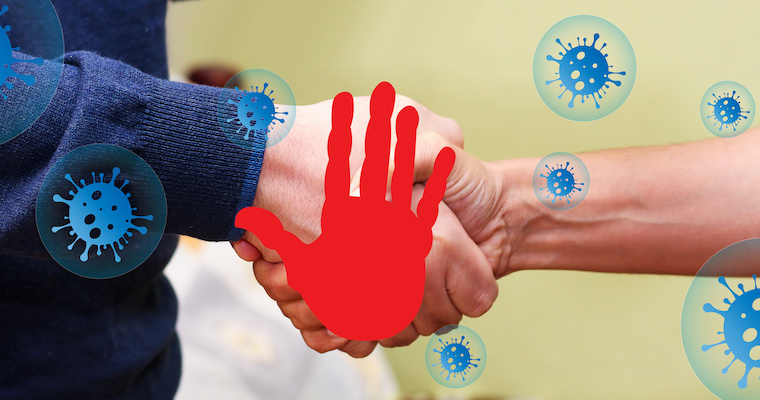Say Goodbye to Handshakes and Hugs

I sent my nephew, a hospital-based internal medicine doctor, a text to let him know I was thinking of him. At the end of the text, I added “sending a big hug,” my usual Aunt Paula close.
“NO HUGGING, AUNT PAULA”, he wrote, all caps and a stern-face emoji.
From 1,600 miles away, his text was not meant to be funny. It was a concern-filled directive against my reflexive behavior to hug. My nephew knows how, as a family, we apply social distancing about as well as a basket of puppies. This tactile show of affection, while wonderful for the warm, fuzzy release of oxytocin, has now become dangerous during this COVID-19 pandemic.
As we enter May, many regions of the US and parts of the world are looking to re-open and resume as many business activities as possible. We should not see this as a “return to normal.” Instead, it’s a new phase in which some social customs return but others will be put on hold until a safer time, and perhaps indefinitely. Around the world, social distancing will be part of the new rules of engagement and to do this will require all of us to consciously change hard-wired cultural norms.
From my 25 years of studying cultural norms, I know that this will not be easy. While nearly everyone comprehends the need for social distancing to limit virus transmission, what we understand can be different from what we do. Understanding the directive is easy. Changing our behavior is difficult because it is a function of the ingrained response based on what we have learned to be culturally appropriate.
Greetings, social distance, and conversational touching are just a few examples of socialized behaviors that differ across cultures. These behaviors were initially taught to us by parents when we were children; they modeled how we should behave to be socially acceptable. As we matured, the norms our parents taught us were either reinforced and strengthened or diluted and weakened, depending on the norms that were modeled at school, work, with friends, in the communities where we lived, etc.
The Strongest Cultural Norms are the Most Difficult to Change
Below are a few examples of social behaviors that might require cultural agility to limit COVID-19 virus transmission.
- Greetings. You have been socialized to greet with a kiss (once, twice, three times, or air), a handshake (soft, hard, double-handed), or a bow (depth, distance, eye contact). In Italy, a double kiss to greet and walking arm and arm with friends is a socialized norm. In Iran, men are socialized to may greet other men with a kiss or handshake – and women kiss women in greetings. In Japan and Korea, bowing at a comfortable social distance is more common.
- Social Distance. How far we stand from people is also a socialized norm. (Consider how “close talkers” make you feel, and you will understand your brain's limbic response to your violated social norm.) A study across 42 countries published in the Journal of Cross-Cultural Psychology found that preferred distances varies dramatically across cultures. Estimating from the chart available in the article, the preferred distance to stand from a stranger in China is about 110 centimeters. By comparison, the social distance in Spain is 90 centimeters from a stranger and about 70 centimeters with an acquaintance. All are under the six-foot minimum recommended in the COVID era.
- Conversational Touching. For some cultures, it is natural to touch an arm to emphasis a point, connect, or show empathy. A study across European countries showed a wide range of variance in how much touch was used in conversation. In Greece, for example, 32% of conversations included some form of touch whereas in the Netherlands it was only 4%.
Using Your Cultural Agility
Acting in a way that is inconsistent with our cultural norm requires cultural agility: the ability to understand the demands of a novel situation and respond as needed. Those with cultural agility use a greater level of deliberate, executive functioning to change their behaviors.
The pandemic is novel to all of us. In this new environment, you might need to adapt your high-touch behaviors by rethinking the outcome or create entirely new behaviors. You can try these:
- Share the challenge. Those in high-touch cultures can verbalize how they would like to act but cannot during the pandemic. You can say “I would love to shake your hand but…”. “I want to give you a hug but…”. “I am going to stand over here because…”. By expressing the non-normative behavior, you are giving your brain’s reflexive processing a license to change.
- Create a new cultural norm. Adopt a behavior that is new to everyone. For example, elbow bumps and foot taps are two great examples of behaviors that are foreign to everyone. You are creating a new cultural norm that fits the novel context (i.e., the pandemic) but one that is new to everyone.
- Focus on the desired outcome. When adopting any counter-culture behavior, we need to move from reflexive, limbic processing to executive, prefrontal cortex processing. One way to do this is to focus on the desired outcome. In this case, it is to keep everyone as healthy as possible.
Let’s hope we can all return to our social norms soon. I, for one, need a hug.
References
Caligiuri, P. (2012). Cultural Agility: Building a Pipeline of Globally Successful Professionals. Jossey-Bass Publishing.
Caligiuri, P. and DeCieri, H. Four Ways Companies Can Support Their Workers During the Coronavirus, The Conversation, April 2020.

